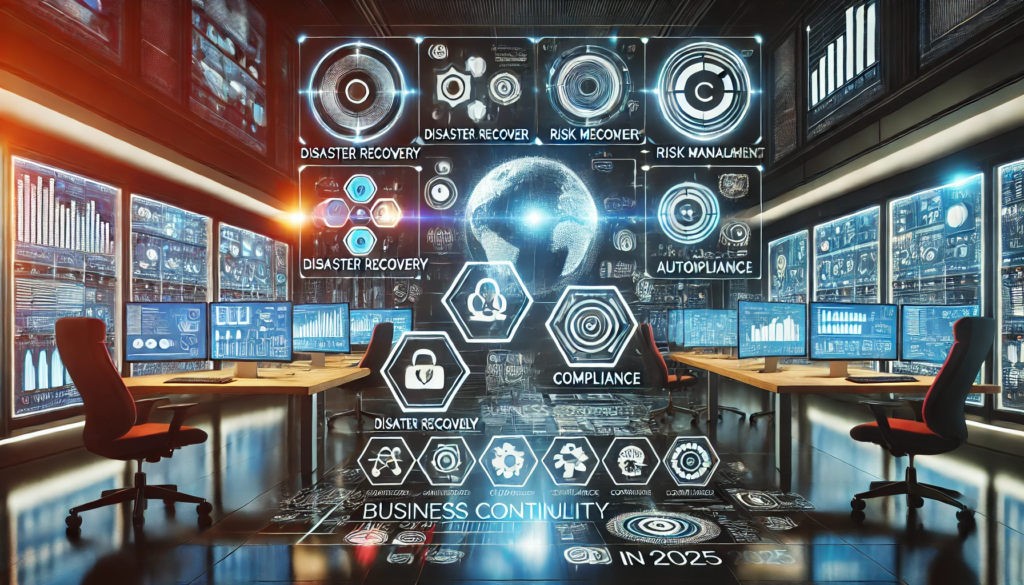Key Takeaways
- Discover the top business continuity software of 2025, offering comprehensive solutions for disaster recovery, risk management, and operational resilience.
- Learn about key features like automated workflows, compliance management, and AI-driven insights to help your organization stay prepared for disruptions.
- Explore customizable, cloud-based platforms with real-time monitoring and incident response capabilities to enhance your business continuity planning.
In the fast-paced and unpredictable business landscape of 2025, organizations are increasingly reliant on robust business continuity strategies to safeguard their operations against disruptions.
Whether it’s a natural disaster, a cyberattack, or an unexpected global event, the need for business continuity software has never been more critical.
Such tools play a pivotal role in ensuring that companies can maintain or quickly resume essential operations, minimizing downtime and reducing the impact of unforeseen events on business functions.

Business continuity software has evolved significantly over the years, now offering more advanced features than ever before.
These solutions are designed to streamline disaster recovery, facilitate risk management, and provide real-time monitoring, all while ensuring compliance with industry standards and regulations.
With the growing threat of cyber threats, climate change, and other global crises, implementing the right business continuity software has become an essential part of a company’s risk management strategy.
Choosing the right software can be a daunting task, given the vast range of options available in the market. However, it is crucial to understand that not all business continuity solutions are created equal.
The best software must offer an array of features that address the unique needs of an organization, ensuring that it can effectively manage risk, respond to disruptions, and quickly resume critical business functions.
This comprehensive guide will provide you with an in-depth look at the top 10 business continuity software options for 2025.
We will explore the features, benefits, and unique selling points of each tool, helping you make an informed decision when selecting the most suitable software for your organization’s continuity needs.
Whether you are a small business or a large enterprise, understanding the key aspects of business continuity software is paramount to ensuring the resilience and longevity of your operations in an increasingly volatile world.
By the end of this guide, you will have a clear understanding of the best business continuity software available in 2025, empowering you to make the right choice for your business’s future.
Before we venture further into this article, we would like to share who we are and what we do.
About 9cv9
9cv9 is a business tech startup based in Singapore and Asia, with a strong presence all over the world.
With over nine years of startup and business experience, and being highly involved in connecting with thousands of companies and startups, the 9cv9 team has listed some important learning points in this overview of the Top 10 Best Business Continuity Software in 2025.
If your company needs recruitment and headhunting services to hire top-quality employees, you can use 9cv9 headhunting and recruitment services to hire top talents and candidates. Find out more here, or send over an email to [email protected].
Or just post 1 free job posting here at 9cv9 Hiring Portal in under 10 minutes.
Top 10 Best Business Continuity Software in 2025: A Complete Guide
- Fusion Framework Systems
- Archer Business Resiliency
- SAI 360
- Fusion Risk Management
- LogicManager
- Riskonnect Business Continuity Management
- BC in the Cloud
- Oracle Risk Management Cloud
- Safety Culture
- iGrafx
1. Fusion Framework Systems

Fusion Framework Systems stands out as one of the top contenders for business continuity software in 2025, offering an integrated risk management platform that excels in both business continuity planning and management. This innovative solution is designed to provide real-time visibility and insights, ensuring that every stakeholder within an organization is promptly informed whenever an incident occurs. By delivering comprehensive solutions for risk management, disaster recovery, and operational resilience, Fusion Framework Systems empowers organizations to not only manage disruptions but to thrive amidst them.
Key Features that Set Fusion Framework Systems Apart:
- Exercise Management: One of the standout features of Fusion Framework Systems is its ability to facilitate regular business continuity exercises. By simulating various disaster scenarios, businesses can pinpoint gaps in their continuity plans, refine their response protocols, and better prepare for real-world disruptions. This feature helps organizations identify weaknesses before a crisis occurs, significantly improving readiness and resilience.
- IT Disaster Recovery: With the increasing reliance on IT infrastructure, ensuring swift recovery from system outages is paramount. Fusion Framework Systems offers comprehensive disaster recovery strategies, which ensure that businesses can minimize downtime and data loss, protecting critical information and maintaining seamless operations even in the face of technological disruptions.
- Dynamic Response and Recovery: Fusion provides an adaptable and flexible response framework that can swiftly adjust to different types and scales of disruptions. Whether dealing with minor interruptions or major disasters, the software enables businesses to recover quickly and efficiently, ensuring minimal impact on operations.
- Dependency Mapping: Another key strength of Fusion Framework Systems is its ability to create detailed maps of interdependencies within an organization. This feature helps businesses identify critical links between departments, processes, and systems, pinpointing potential vulnerabilities. By understanding these dependencies, businesses can build more resilient continuity plans, minimizing risk exposure.
Industries that Benefit Most from Fusion Framework Systems:
Fusion Framework Systems caters to a diverse range of industries, including:
- Finance: Financial institutions that require rigorous risk management and disaster recovery strategies to protect sensitive data and maintain regulatory compliance.
- Manufacturing: Manufacturers can rely on Fusion to ensure that production processes are resilient, even when facing disruptions in supply chains or operations.
- Tech and Data Service Providers: Companies in the tech sector, particularly those dealing with critical data, rely on Fusion’s robust disaster recovery capabilities to ensure business continuity and data protection.
Why Fusion Framework Systems is Among the Best Business Continuity Software in 2025:
Fusion Framework Systems is not just about planning for potential disasters; it’s about proactive and intelligent risk management. By enabling organizations to map their critical processes and gain insights into potential vulnerabilities, Fusion allows businesses to fine-tune their continuity strategies, ensuring they are as prepared as possible for disruptions. The software’s capacity for scenario-based exercises, such as task assignments, communication, and reporting during a disaster, enhances an organization’s ability to react quickly and effectively when a real crisis occurs.
Moreover, the software offers both business continuity management and disaster recovery, ensuring that businesses are equipped to handle disruptions, whether from technological failures, natural disasters, or other crises. The platform’s user-friendly data entry and reporting systems make it easy for teams to keep information updated and accessible, allowing for informed decision-making during critical moments.
Additional Key Features:
- What-if Scenarios: Businesses can model various risk scenarios to understand their potential impact and better prepare for the unexpected.
- Plan Evaluations and Risk Assessments: Continuous evaluation of business continuity plans allows organizations to stay ahead of potential threats.
- Visual Process Maps: These maps offer a clear and intuitive representation of business operations, ensuring that teams can quickly grasp the impact of disruptions and identify mitigation strategies.
- Customizable Risk Tolerances and Third-Party Risk Management: Fusion offers flexibility by allowing businesses to tailor risk tolerance levels according to their specific needs while also managing risks associated with third-party vendors.
Pros of Fusion Framework Systems:
- Robust and Flexible Reporting: The software offers detailed reporting capabilities, enabling businesses to track trends, identify risk areas, and document successful mitigation efforts.
- User-Friendly Interface: Fusion’s intuitive interface ensures ease of use, making it accessible to teams at all levels.
- Active and Supportive User Community: The platform boasts a vibrant community of users who actively share insights, solutions, and best practices, fostering a collaborative environment for continuous improvement.
In conclusion, Fusion Framework Systems offers an all-encompassing solution for business continuity and risk management, making it an indispensable tool for organizations aiming to enhance resilience in 2025. With its comprehensive features, industry-specific applications, and dynamic response capabilities, it is an ideal choice for businesses looking to safeguard their operations and maintain continuity, no matter the scale of disruption they face.
2. Archer Business Resiliency

Archer Business Resiliency stands as a powerful tool among the top business continuity software solutions in 2025, offering organizations a comprehensive platform for safeguarding their operations against potential disruptions. By combining advanced risk management, disaster recovery planning, and crisis management, Archer helps businesses not only prepare for unforeseen events but also react swiftly when challenges arise. This sophisticated software allows organizations to pinpoint critical business processes, assess associated risks, and develop disaster recovery plans tailored to minimize downtime and maintain operations. With its focus on automation and real-time responses, Archer Business Resiliency significantly enhances a company’s ability to recover quickly during emergencies.
Key Features that Position Archer Business Resiliency as a Top Contender in 2025:
- Impact Analysis: Archer’s impact analysis capabilities provide businesses with a detailed understanding of the potential consequences of disruptions. By analyzing which processes are most vulnerable to outages, organizations can prioritize their resources and recovery efforts, ensuring that critical operations are maintained or rapidly restored.
- Comprehensive Risk Assessments: With its robust risk assessment tools, Archer helps organizations evaluate both internal and external threats, enabling them to identify potential risks that could disrupt their business operations. By gaining deep insights into these risks, businesses can proactively address vulnerabilities and enhance their resilience.
- Automated Disaster Recovery: Archer’s automation feature is one of its standout offerings, allowing businesses to initiate recovery plans and execute response strategies automatically during a crisis. This minimizes response time and ensures that critical recovery actions are taken immediately, reducing the impact of outages and accelerating recovery.
- Risk Insights: The software delivers in-depth risk insights, enabling organizations to determine which processes are most susceptible to disruption and where mitigation efforts should be focused. This helps organizations make informed decisions when crafting recovery plans, ensuring that all potential risks are addressed.
- Scenario Testing: Archer also excels in scenario-based testing, allowing businesses to simulate different types of disruptions and evaluate how their plans would hold up under various conditions. This feature helps organizations refine their recovery strategies, ensuring they are fully prepared for any eventuality.
- Third-Party Risk Management: In today’s interconnected world, third-party relationships are often a key vulnerability. Archer’s third-party risk management capabilities allow organizations to assess and manage the risks associated with vendors and external partners, ensuring that these relationships do not compromise the business continuity plan.
Why Archer Business Resiliency is a Leading Choice for Business Continuity in 2025:
Archer Business Resiliency is designed to seamlessly integrate with an organization’s broader objectives, making it a versatile solution for companies across industries. The software blends business continuity management (BCM) with IT disaster recovery, crisis management, and incident recovery services, providing a unified platform to address the full spectrum of business resilience needs. By automating key processes, such as disaster recovery and continuity planning, Archer ensures that organizations can respond to crises with remarkable speed and coordination, reducing both operational and financial risks.
In addition to its disaster recovery features, Archer Business Resiliency supports proactive planning and reactive responses, empowering organizations to handle disruptions of all kinds. The software enables businesses to create both proactive contingency plans to mitigate risks and reactive plans that activate quickly in the face of disruptions. This dual approach strengthens an organization’s ability to adapt and recover efficiently, whether responding to natural disasters, cyberattacks, or supply chain interruptions.
Another significant strength of Archer is its ability to generate detailed reports, both standard and custom, providing businesses with valuable insights into their continuity planning and recovery efforts. These reports not only support decision-making but also enable companies to track the progress of their resilience initiatives, ensuring that they are continually improving their business continuity strategies.
Additional Key Features and Benefits:
- Highly Detailed Reporting: Archer’s reporting capabilities are robust and flexible, offering businesses both standardized and customizable options to meet their specific needs. Whether tracking compliance, testing results, or risk assessments, these reports help businesses measure their performance and identify areas for improvement.
- Flexible and Scalable Platform: Archer Business Resiliency is designed to accommodate businesses of various sizes and sectors. Its flexible platform allows it to scale and adapt to the unique requirements of any organization, from small enterprises to large multinational corporations.
- Efficient Plan Execution: With Archer, organizations can automate the execution of their continuity and disaster recovery plans, ensuring that actions are initiated promptly and with minimal human intervention. This ensures that recovery efforts are not delayed and that teams are immediately aligned during a crisis.
Conclusion:
In summary, Archer Business Resiliency distinguishes itself as one of the best business continuity software solutions in 2025 by offering a comprehensive suite of features that prioritize automation, risk management, and recovery speed. Its ability to analyze risks, simulate scenarios, and generate detailed reports makes it a powerful tool for businesses seeking to safeguard their operations and ensure resilience. With its focus on seamlessly integrating business continuity into the organization’s broader objectives, Archer is an indispensable asset for any company aiming to maintain uninterrupted operations in an increasingly unpredictable world.
3. SAI 360

SAI360 stands out as one of the premier business continuity software solutions in 2025, offering organizations an exceptional range of tools to ensure comprehensive coverage of critical operations. Its robust capabilities are designed to protect essential processes, providing organizations with the clarity and flexibility needed to streamline decision-making and collaboration, all while eliminating redundancies across data and terminology. The platform helps businesses ensure that every vital operation is accounted for, thus safeguarding them from disruptions and facilitating swift recovery in the event of a crisis.
One of the most notable aspects of SAI360 is its ability to elevate crisis management by seamlessly escalating incidents into major crisis events. The software offers a real-time, mobile-responsive interface that allows teams to assign tasks, monitor progress, and measure performance against recovery time objectives (RTOs). This feature ensures a rapid and coordinated response to any emergency, mitigating the impact of disruptions.
Key Features:
- Crisis Management Activation: The software allows businesses to quickly escalate incidents into crisis events, assign specific tasks, and track performance against RTOs, all through a real-time, mobile-compatible interface.
- Emergency Notifications: By integrating with mass notification systems like OnSolve and Everbridge, SAI360 ensures immediate communication with teams and stakeholders, making it easier to manage crises effectively.
- Global Deployment: The platform supports global deployment, with features such as localization of date formats and multilingual content, allowing businesses to operate seamlessly across diverse geographical regions.
- Business Impact Assessment (BIA): SAI360 enables businesses to conduct comprehensive BIAs, which are essential for identifying critical processes and evaluating potential impacts, thus improving recovery planning.
Industries Served by SAI360: SAI360 is utilized by a diverse array of industries, including banking and financial services, healthcare, manufacturing, mining, energy, utilities, technology, and pharmaceuticals. Its versatile nature allows it to address the specific business continuity challenges of each sector, tailoring solutions to meet unique operational requirements.
Why SAI360 is Among the Top 10 Best Business Continuity Software in 2025
SAI360’s strength lies in its all-encompassing approach to business continuity and crisis management. The software goes beyond just disaster recovery by integrating incident response, business impact assessment, and performance monitoring in one cohesive platform. This holistic approach allows businesses to not only prepare for but also swiftly respond to disruptions, keeping critical services operational during crises.
The platform’s ability to expand coverage across critical business processes ensures that no essential operation is left unprotected, and its data-driven approach to prioritizing recovery efforts makes it easier for organizations to allocate resources effectively. SAI360’s emphasis on crisis management and business impact analysis allows organizations to identify potential risks and implement strategies to reduce the consequences of disruptions, all while maintaining operational continuity.
Moreover, SAI360’s mobile-responsive interface and global deployment features make it a highly accessible and versatile solution. Whether an organization operates locally or internationally, the software ensures that recovery efforts are streamlined and efficient, no matter where the incident occurs.
The Importance of Business Continuity and Planning
Business continuity (BC) refers to the processes and strategies that ensure an organization can continue its essential functions during major disruptions, whether due to natural disasters, cyberattacks, pandemics, or financial crises. Business continuity planning (BCP) outlines the specific actions and steps an organization will take to maintain or restore operations after a crisis. It is an indispensable aspect of modern business, ensuring that companies can navigate unexpected events without significant operational losses or prolonged downtime.
A well-crafted business continuity plan (BCP) provides clear guidance on how an organization will continue functioning during an emergency. While closely related to disaster recovery planning, BC focuses on sustaining operations with minimal disruption. An effective BCP should address risk management, business impact analysis (BIA), incident response, and recovery strategies to ensure swift recovery and minimize financial losses.
Comprehensive Business Continuity Planning with SAI360
SAI360’s comprehensive approach to business continuity includes several key components that make it a standout solution for 2025:
- Risk Management: SAI360 helps organizations identify, assess, and mitigate risks that could affect critical functions. The platform’s cross-functional coordination ensures that businesses are prepared for staffing shortages, resource disruptions, and other operational challenges.
- Business Impact Analysis (BIA): SAI360 provides tools for conducting thorough BIAs to identify mission-critical processes, assess potential impacts, and define recovery timelines, making it easier for businesses to plan and respond effectively.
- Incident Response and Crisis Management: The platform’s crisis management features enable organizations to escalate incidents into full-scale crisis events, assign tasks, and track performance against RTOs, ensuring a swift and coordinated response.
- Global Scalability: SAI360’s ability to scale globally makes it suitable for organizations with a worldwide presence. Features like localization and multilingual content ensure that businesses can deploy the solution across different regions with ease.
The Role of Business Continuity Software in Modern Business Operations
Business continuity software plays an essential role in today’s rapidly changing business landscape. With increasing reliance on digital infrastructure and interconnected systems, organizations must be prepared for a wide range of disruptions. The adoption of business continuity software helps organizations:
- Ensure the protection of mission-critical functions and systems during crises
- Maintain effective communication during emergencies
- Facilitate swift recovery and minimize downtime
- Stay compliant with regulatory requirements related to business continuity
In addition to these benefits, business continuity software allows organizations to continuously assess their plans through testing and exercises, ensuring they are prepared for various crisis scenarios.
Conclusion
SAI360 is among the best business continuity software solutions in 2025 because it offers a comprehensive, flexible, and data-driven approach to crisis management and operational recovery. The platform’s ability to provide real-time monitoring, global scalability, and seamless integration with mass notification systems makes it a vital tool for organizations looking to safeguard their operations against disruptions. By combining robust crisis management features, a data-driven approach to recovery, and a user-friendly mobile interface, SAI360 empowers businesses to not only survive disruptions but thrive despite them.
4. Fusion Risk Management

Fusion Risk Management stands out in the landscape of business continuity software by offering a comprehensive solution that not only supports traditional business continuity planning but also integrates risk management, crisis management, third-party risk assessments, and IT security resilience. As businesses face an ever-growing array of potential disruptions—from cyberattacks to operational failures—Fusion’s multifaceted approach is designed to ensure organizations can navigate these challenges with agility and precision.
Fusion Framework System—Fusion’s flagship business continuity software—offers a powerful suite of tools that chart every aspect of a business’s processes. This process-mapping feature allows businesses to uncover interdependencies, evaluate critical operations, and identify potential risks that could disrupt these vital functions. With this visibility, organizations can determine their impact tolerances, which is crucial for setting realistic recovery time objectives (RTOs) and ensuring that any crisis response is tailored to their unique needs.
What truly sets Fusion apart is its ability to perform comprehensive “what-if” scenario analyses. By simulating a variety of crisis situations, the software enables businesses to better prepare for both expected and unexpected disruptions. This proactive approach fosters operational resilience, equipping organizations with the tools they need to adapt swiftly in times of uncertainty. Furthermore, Fusion recently incorporated generative AI-powered assistants, which add another layer of support to the resilience planning process by offering intelligent insights and recommendations tailored to the organization’s specific risk profile.
Highly regarded by both industry professionals and analysts alike, Fusion Risk Management is often described as a top-tier business continuity solution, consistently earning high marks in evaluations by leading authorities such as Gartner. Several features contribute to its status as a preferred choice for organizations aiming to strengthen their resilience capabilities:
- Configurable Methodology: Fusion is known for its exceptional flexibility. It can be easily tailored to meet the unique needs of different organizations, offering out-of-the-box methodologies that align with the goals of most business continuity programs.
- Seamless Integration with Salesforce: Built on the Force.com platform (Salesforce), Fusion benefits from the scalability and stability of Salesforce’s cloud infrastructure. Organizations already familiar with Salesforce can quickly adapt to the system, minimizing the learning curve and easing configuration efforts.
- Cloud-Based Infrastructure: Being cloud-based, Fusion reduces the need for ongoing internal IT support. Initial configuration is typically managed in partnership with Fusion, and subsequent maintenance and support are handled by the company, freeing internal resources to focus on core business activities.
- Comprehensive Crisis Management: Fusion empowers businesses to simulate real-world crisis scenarios using its dynamic framework. Role definitions within the system ensure clarity, outlining who is responsible for what during a crisis, including emergency notification tasks.
- Impact Tolerances and Automation: The ability to set specific impact tolerances—such as acceptable levels of downtime and lost productivity—ensures that the system can automate first-response actions. This level of automation helps organizations react swiftly and effectively when disaster strikes.
Additionally, Fusion offers a wealth of features that contribute to operational robustness:
- Advanced Reporting Tools: The platform includes detailed reporting capabilities, enabling businesses to track performance, identify gaps, and improve the overall efficiency of their continuity plans.
- User-Friendly Interface: Despite its powerful functionality, Fusion maintains an intuitive and easy-to-navigate interface, making it accessible for teams across departments, from risk management to IT.
- Flexible and Scalable Platform: Fusion’s versatility ensures that it can adapt to organizations of all sizes, from small businesses to large enterprises, making it a highly scalable solution.
- Risk Evaluation and Assessment: With built-in tools for evaluating and assessing various risks, Fusion allows businesses to identify potential threats and mitigate them before they cause significant disruption.
- Visual Process Mapping: The software’s visual process maps provide a clear, graphical representation of business workflows and interdependencies, allowing organizations to better understand their critical operations and the potential impact of disruptions.
- Disaster Recovery and Incident Management: In addition to business continuity, Fusion offers robust disaster recovery features and incident management tools, ensuring that organizations can recover efficiently and resume operations as quickly as possible.
Conclusion: Why Fusion Risk Management is One of the Top 10 Business Continuity Software Solutions in 2025
Fusion Risk Management’s ability to provide a comprehensive, customizable, and cloud-based solution for business continuity management makes it one of the top contenders in 2025. Its deep integration of risk management, crisis response, and IT security, along with its AI-powered resilience planning capabilities, ensures that organizations can not only plan for disasters but also mitigate risks and recover swiftly. With an intuitive user interface, powerful reporting, and unparalleled flexibility, Fusion is designed to support businesses across a wide range of industries and operational scales. Whether you’re looking to streamline your crisis management processes or enhance your organization’s ability to recover from disruptions, Fusion Risk Management offers the tools and features necessary to strengthen your operational resilience.
5. LogicManager

As an established and trusted name in the business continuity management (BCM) field, LogicManager offers a highly effective enterprise risk management (ERM) platform tailored to address the complexities of modern business environments. This software empowers organizations to anticipate, plan for, and recover from disruptions with the aid of automation and comprehensive risk management strategies. Recognized for its industry leadership, LogicManager has garnered significant accolades, including being named a Leader in the 2020 Forrester Wave™ for Governance, Risk, and Compliance Platforms, and earning a spot in Gartner’s Magic Quadrant for IT Risk Management Tools. These distinctions underscore the software’s ability to streamline business continuity efforts and enhance overall operational resilience.
Key Features of LogicManager’s BCM Platform
At the heart of LogicManager’s offering is its cloud-based software-as-a-service (SaaS) platform, which encompasses more than 120 distinct solutions designed to address the diverse and evolving challenges enterprises face in an increasingly interconnected world. One of the standout capabilities of LogicManager is its ability to simulate various crisis scenarios through disaster simulations, allowing businesses to practice their continuity plans and fine-tune their responses to different types of disruptions.
The software also incorporates a comprehensive Business Impact Analysis (BIA) dashboard, helping organizations visualize the potential impacts of disruptions on their critical functions. By using pre-built BIA templates, companies can identify their most vital processes and focus recovery efforts where they matter most. The ability to conduct continuous impact assessments enables businesses to remain proactive, ensuring that their continuity plans are not only up-to-date but also aligned with current risk landscapes.
Automation and Customization for Maximum Efficiency
One of LogicManager’s most valuable features is its focus on automation. The platform streamlines the continuity planning process by automatically generating business continuity plan (BCP) testing reports and updating critical data, such as contact lists, without manual intervention. For example, LogicManager’s integration with HRIS applications ensures that call trees are updated automatically each night, saving time and reducing the potential for human error during an emergency.
The software’s intuitive, customizable interface further enhances its accessibility. LogicManager’s user-friendly design allows companies to tailor their dashboards and workflow capabilities based on individual roles and responsibilities, providing all stakeholders with the information they need to act swiftly in the event of a crisis. This feature is particularly useful for large organizations that require a high level of granularity and specificity in their continuity plans.
Governance, Risk, and Compliance Integration
LogicManager is not just a business continuity tool—it’s a comprehensive enterprise risk management solution that seamlessly integrates governance, risk management, and compliance processes into a single platform. The software helps organizations identify and mitigate risks, track compliance with industry regulations (such as ISO 27001, HIPAA, and PCI DSS), and monitor the progress of continuity initiatives. This all-in-one approach makes LogicManager especially appealing for mid-sized enterprises that need a solution capable of consolidating their risk management, compliance, and continuity planning efforts in one place.
Business Continuity for the Modern Enterprise
LogicManager’s enterprise risk management platform is especially well-suited for organizations in sectors such as healthcare, financial services, insurance, and transportation, where maintaining operational continuity is critical. By enabling businesses to assess risk in real time and automate critical processes, LogicManager ensures that continuity plans can be implemented efficiently and consistently, even in the face of an unforeseen crisis.
The software’s reporting and dashboard features further solidify its position as one of the top business continuity management tools. These features allow organizations to track progress, visualize risk landscapes, and report on compliance with relevant regulations. The ability to generate customizable reports ensures that stakeholders—from IT teams to auditors—receive the insights they need to make informed decisions and demonstrate compliance to regulatory bodies.
Comprehensive Risk Management for All Business Continuity Needs
LogicManager’s Business Continuity Management (BCM) platform offers a complete suite of solutions designed to empower organizations to manage and recover from disruptions effectively. Whether it’s conducting risk assessments, performing business impact analysis, tracking compliance, or automating critical workflows, LogicManager is built to help businesses mitigate risk and enhance resilience.
Notably, the workflow automation feature ensures that tasks are assigned to the appropriate teams, streamlining the planning process and ensuring that continuity efforts remain on track. The proactive BIA approach encourages organizations to conduct regular assessments to ensure their business continuity plans stay relevant and responsive to changing conditions.
Why LogicManager Stands Out in 2025
In 2025, LogicManager continues to be recognized as one of the best business continuity software solutions available. The platform’s versatility in risk assessment, workflow automation, and compliance management makes it a top choice for organizations seeking to improve their business continuity and disaster recovery capabilities. Its focus on real-time monitoring, automated testing, and disaster simulations allows businesses to stay one step ahead of potential disruptions, ensuring that operations can quickly resume when crises occur.
While LogicManager does not offer native backup and recovery features, its comprehensive approach to business continuity—combined with its ability to integrate with existing IT infrastructures and automate key processes—makes it a valuable tool for organizations looking to enhance resilience and ensure long-term success in an unpredictable world.
For organizations that need a centralized, data-driven solution for managing risk, compliance, and business continuity, LogicManager remains a top contender, offering powerful tools to help businesses prepare for, recover from, and ultimately thrive in the face of disruptions.
6. Riskonnect Business Continuity Management

Riskonnect stands out as a premier provider of integrated risk management software, offering a comprehensive Business Continuity & Resilience platform designed to help organizations prepare for and respond to potential disruptions. As one of the most highly regarded solutions in the industry, Riskonnect’s software is engineered to safeguard operations, minimize downtime, and enhance preparedness for a wide range of threats. Serving over 2,000 customers globally, Riskonnect’s robust suite of tools positions it among the top business continuity software choices for 2025.
A Comprehensive Approach to Business Continuity and Resilience
What sets Riskonnect Business Continuity Management (BCM) apart is its ability to centralize and automate various aspects of continuity planning and operational resilience. The platform allows businesses to manage disaster readiness through a centralized dashboard that brings together critical components such as risk assessments, vulnerability detection, crisis management, and real-time communication. This centralized approach ensures that organizations can quickly access and update their business continuity plans, minimizing the risk of outdated strategies that fail to address emerging threats.
The software’s Key Performance Indicators (KPIs) framework is one of its defining features, enabling businesses to continuously monitor and evaluate their preparedness. By allowing companies to experiment with various what-if models, Riskonnect helps them simulate different crisis scenarios and assess the effectiveness of their response strategies in real time. This proactive approach to risk assessment is vital, as it helps companies identify gaps and vulnerabilities that might otherwise remain hidden, giving them the tools they need to address these vulnerabilities before they become critical issues.
Automation to Ensure Consistency and Timely Reviews
One of the biggest challenges for organizations when it comes to business continuity is the review and update cycle. Without regular revisions, business continuity plans can quickly become obsolete, leaving companies vulnerable when crises strike. Riskonnect mitigates this challenge by automating the review, update, and approval processes, ensuring that plans remain current and actionable. This automation not only saves time but also ensures that the most up-to-date strategies are in place, enabling businesses to respond swiftly and effectively in the event of an emergency.
End-to-End Digital Model for Comprehensive Risk Management
Riskonnect’s Business Continuity software is more than just a planning tool; it is a digital model that provides organizations with a holistic view of their operations, vulnerabilities, and dependencies. By mapping out an organization’s obligations, dependencies, and vulnerabilities, the platform helps businesses understand the full scope of potential threats to their operations. It also enables them to stress-test their plans against a variety of disruption scenarios, ensuring that their strategies are both robust and flexible.
In addition to helping organizations with their disaster preparedness, Riskonnect provides a variety of additional services that further enhance operational resilience. These include crisis management, emergency notifications, and business continuity consulting, ensuring that companies are not only prepared but also supported throughout the process of strengthening their resilience. By combining software with managed services, Riskonnect offers a truly comprehensive solution to meet the needs of modern businesses.
Compliance and Regulatory Alignment
In 2025, ensuring compliance with industry regulations is a top priority for many organizations. Riskonnect’s software is fully aligned with ISO 22301, the international standard for business continuity management systems, as well as other regulatory frameworks related to disruption prevention and service continuity. This makes it an invaluable tool for companies in highly regulated industries, helping them to meet compliance requirements while strengthening their continuity strategies.
Key Features of Riskonnect Business Continuity Software
- Dynamic Business Continuity Plans: Instantly access and update business continuity plans from a centralized location. The platform ensures that plans remain up-to-date and accessible when needed most.
- Vulnerability Detection: Identify hidden vulnerabilities and program gaps that could hinder the effectiveness of response and recovery strategies. This proactive feature allows businesses to address potential issues before they escalate.
- Real-Time Crisis Management: In the event of a disruption, Riskonnect ensures that organizations can respond effectively with live situation reporting, online plan activation, and timely communication with key stakeholders.
- Automated Reviews and Approvals: Automate the crucial review and approval cycles of business continuity plans to ensure they remain current and compliant with industry standards and regulations.
- Operational Resilience: Beyond business continuity, the platform enhances overall operational resilience by helping organizations track and manage their resilience strategies, ensuring that they can recover quickly and minimize disruption.
- Regulatory Compliance: Align business continuity practices with key regulations like ISO 22301, ensuring that organizations meet the necessary legal and compliance standards while maintaining operational readiness.
Why Riskonnect is a Leading Choice for 2025
As organizations continue to face an ever-growing range of risks and threats, the need for a robust, integrated solution for business continuity has never been greater. Riskonnect’s Business Continuity & Resilience software stands out as one of the best options for 2025, offering a comprehensive, automated, and proactive approach to disaster preparedness. By combining dynamic modeling, real-time crisis management, and seamless integration with existing risk management processes, Riskonnect provides businesses with the tools they need to not only prepare for disruptions but also to respond effectively and recover swiftly.
In addition to its powerful features, Riskonnect’s ability to integrate compliance management with operational resilience makes it a standout choice for businesses seeking a solution that meets both regulatory requirements and strategic business needs. With a customer base of over 2,000 companies, including leaders in industries such as healthcare, finance, and manufacturing, Riskonnect has proven itself as a trusted partner for organizations aiming to enhance their business continuity and operational resilience in 2025 and beyond.
7. BC in the Cloud

In 2025, BC in the Cloud is emerging as one of the premier cloud-based solutions for business continuity management. Offering organizations an efficient and streamlined approach to crisis management, disaster recovery, and incident response, this platform is rapidly gaining recognition for its comprehensive features and ease of use. Designed to ensure that businesses can quickly recover from disruptions, BC in the Cloud is a powerful tool for any organization aiming to minimize downtime and enhance operational resilience in an increasingly unpredictable world.
Cloud-Based Flexibility for Global Accessibility and Disaster Preparedness
One of BC in the Cloud’s standout features is its cloud-based architecture, which ensures that business continuity plans remain accessible from virtually any location worldwide, even in the face of server downtime. This flexibility provides organizations with the assurance that their critical data and recovery plans will remain intact and operational no matter where they are, ensuring seamless access even during a crisis. With this cloud-based solution, businesses are empowered to manage their continuity strategies with minimal training and maximum flexibility.
The platform offers pre-defined templates and maps that businesses can configure and tailor according to their specific needs, allowing for quick deployment and effective continuity planning. This out-of-the-box functionality reduces the time and effort required for businesses to set up their continuity programs, making it an ideal solution for companies looking to implement disaster recovery strategies with ease and speed.
Key Features for Streamlined Crisis Management and Disaster Recovery
BC in the Cloud excels in helping organizations automate business continuity and disaster recovery programs, ensuring that businesses are always prepared for unexpected disruptions. The platform’s comprehensive suite of features includes crisis management, incident management, real-time communication, and reporting capabilities. By centralizing all these essential elements into a single platform, BC in the Cloud simplifies the planning, preparation, and execution of continuity plans, enabling businesses to react swiftly to any challenge.
One of the platform’s most valuable features is its mass notification system, which ensures that real-time communication is maintained among team members, stakeholders, and key personnel during a crisis. This ensures that all parties remain informed and aligned, enabling rapid decision-making and a coordinated response effort. The inclusion of data integration capabilities allows BC in the Cloud to pull relevant data from existing systems, offering a comprehensive view of the organization’s vulnerabilities, business impacts, and recovery needs.
Comprehensive Disaster Recovery and Incident Management Tools
BC in the Cloud’s disaster recovery and incident management capabilities are second to none, enabling businesses to respond effectively and minimize operational disruptions. The platform’s automated workflows streamline incident response processes, making it easier for organizations to manage recovery efforts without unnecessary delays. This ensures that recovery plans are executed efficiently, with designated actions, timelines, and responsible parties clearly identified for each disruption scenario.
In addition, the software provides businesses with scenario-based testing tools to conduct regular drills and simulations, allowing them to test the effectiveness of their recovery plans and identify areas for improvement. This proactive approach to testing is critical for ensuring that recovery strategies remain robust and effective when faced with real-world disruptions.
Advanced Risk Assessment and Reporting Capabilities
BC in the Cloud also features advanced risk assessment tools that enable businesses to identify potential threats and vulnerabilities that could disrupt their operations. By conducting Business Impact Analysis (BIA), organizations can pinpoint their most critical functions and assess the potential impact of disruptions on those functions. This information is then used to prioritize recovery efforts, ensuring that businesses can address the most pressing risks first.
The reporting and analytics tools included in BC in the Cloud provide organizations with detailed insights into their recovery plans, incident response performance, and risk assessments, helping them monitor progress and identify areas that need attention. The dashboard displays key metrics and allows users to generate customized reports that can be shared with stakeholders to ensure everyone is aligned and informed.
Benefits of Using BC in the Cloud
- Improved Resilience: The platform’s proactive planning and testing capabilities ensure that businesses can minimize disruptions and continue operations during emergencies. By identifying vulnerabilities before they become critical, organizations can bolster their resilience against a wide range of risks.
- Faster Recovery: BC in the Cloud’s automated workflows and streamlined processes expedite recovery time, enabling businesses to return to normal operations quickly and efficiently.
- Enhanced Collaboration: With its centralized platform, BC in the Cloud enables all stakeholders to access and update business continuity plans in real-time, ensuring seamless collaboration between teams and departments during a crisis.
- Cost Efficiency: Being a cloud-based platform, BC in the Cloud eliminates the need for costly on-premise hardware and software maintenance, reducing overhead costs and improving cost-effectiveness.
- Customization and Flexibility: The platform offers a high level of configuration flexibility, allowing businesses to tailor the solution to their specific needs and adapt it as circumstances change.
Why BC in the Cloud is a Top Contender for Business Continuity Software in 2025
In the evolving landscape of business continuity and disaster recovery, BC in the Cloud has cemented its position as one of the top 10 best business continuity software solutions in 2025. Its cloud-based architecture, comprehensive features, and user-friendly design make it a standout choice for organizations of all sizes. With capabilities like real-time communication, risk assessment, incident management, and disaster recovery planning, the platform empowers businesses to stay ahead of disruptions and recover with speed and efficiency.
The software’s seamless integration with existing systems, pre-configured templates, and customizable reportsfurther enhance its value, enabling businesses to streamline their continuity planning and response processes. As organizations continue to face an increasing range of potential disruptions, BC in the Cloud offers a proven, cost-effective, and flexible solution for ensuring operational resilience and business continuity. With its focus on automation, ease of use, and real-time collaboration, BC in the Cloud is poised to remain a leading choice for businesses looking to safeguard their operations and recover from unexpected disruptions in 2025 and beyond.
8. Oracle Risk Management Cloud

As organizations continue to prioritize business continuity in 2025, Oracle Risk Management Cloud stands out as a premier solution, particularly for its robust focus on fraud prevention, cybersecurity, and operational resilience. While not centered on traditional disaster recovery, Oracle Risk Management Cloud provides organizations with a comprehensive toolkit for mitigating risks and protecting sensitive data from cyber threats, fraud, and operational disruptions. By leveraging the power of artificial intelligence (AI), seamless integration with Oracle ERP, and a range of advanced security features, Oracle Risk Management Cloud is emerging as a vital component for ensuring continuity in an increasingly complex and volatile business environment.
Integrated Risk Management for Enhanced Resilience
Oracle Risk Management Cloud is strategically designed to help businesses assess and manage a broad spectrum of risks, from cyberattacks to operational failures. Through its integration with Oracle ERP, the platform ensures that critical data flows across business operations while safeguarding against potential threats. By tracking user activities and behaviors, Oracle Risk Management Cloud employs AI to automatically detect and block suspicious actions, preventing fraud and securing business transactions in real-time. This seamless integration allows for a holistic view of organizational operations, fostering a proactive approach to risk management and business continuity.
One of the standout features of the Oracle Risk Management Cloud is its pre-built security rules, which simplify the process of assigning user permissions while maintaining strict control over sensitive information. These security protocols ensure that businesses can easily manage access control, thereby protecting critical data in a centralized repository. The combination of AI-driven monitoring and automated workflows allows organizations to respond swiftly to emerging threats and streamline operational processes.
Key Features for Risk Management and Business Continuity
Oracle Risk Management Cloud provides a comprehensive set of tools designed to strengthen an organization’s ability to navigate risks, particularly in areas related to cybersecurity, operational disruptions, and compliance with industry standards. These features include:
- Risk Identification and Assessment: The platform offers powerful tools to identify and assess potential risks across various operational domains. Whether it’s cyber threats, natural disasters, or system failures, Oracle Risk Management Cloud provides organizations with the ability to analyze and quantify potential risks before they escalate.
- Business Impact Analysis (BIA): The BIA functionality allows businesses to analyze the criticality of their processes, determine potential operational impacts in the event of disruptions, and prioritize recovery strategies based on severity and business function importance.
- Contingency Planning: Oracle Risk Management Cloud empowers organizations to develop detailed recovery plans for high-risk scenarios, including data backup procedures, alternative work locations, and comprehensive communication strategies to ensure continuous operations during emergencies.
- Incident Management: The platform features a streamlined process for managing incidents during a crisis, including escalation procedures, task assignments, and real-time status updates. This feature ensures that businesses can manage incidents efficiently and maintain continuity throughout the disruption.
- Communication Management: In times of crisis, effective communication is critical. Oracle Risk Management Cloud equips organizations with tools to maintain clear, consistent communication across all levels, from predefined communication plans to automated stakeholder notifications.
- Reporting and Analytics: The platform offers extensive reporting tools, enabling businesses to generate customizable reports on risk mitigation efforts, business continuity preparedness, and progress toward operational resilience goals. These insights empower organizations to continuously refine and strengthen their continuity strategies.
- Workflow Automation: Automated workflows are a core feature of Oracle Risk Management Cloud, streamlining critical processes such as risk assessments, plan updates, and incident response management. Automation reduces the manual effort required to manage business continuity plans, improving overall efficiency and responsiveness.
- Integration with Other Oracle Systems: Oracle Risk Management Cloud seamlessly integrates with other Oracle applications, such as ERP and Human Capital Management (HCM) systems, ensuring that risk management is aligned across the entire organization. This integration allows for a comprehensive and unified approach to managing operational risks and business continuity.
- Compliance Management: The platform helps businesses stay compliant with industry regulations, aligning with standards like ISO 22301 and other relevant guidelines for business continuity planning. This makes it easier for organizations to meet regulatory requirements and avoid potential penalties.
Benefits of Oracle Risk Management Cloud for Business Continuity
- Proactive Risk Mitigation: By identifying and addressing risks before they materialize into major disruptions, Oracle Risk Management Cloud helps businesses maintain operational integrity and minimize the impact of potential threats.
- Improved Operational Resilience: The platform’s robust risk management and continuity planning tools ensure that critical business functions can continue operating during and after an incident, helping organizations maintain service levels and customer trust.
- Enhanced Decision-Making: With data-driven insights and real-time analytics, Oracle Risk Management Cloud empowers organizations to make informed, strategic decisions about business continuity planning and risk management.
- Streamlined Processes: The automated workflows and centralized platform reduce administrative overhead and improve the efficiency of business continuity management activities. This allows organizations to focus on strategic priorities while ensuring that continuity plans are continually updated and tested.
- Comprehensive Risk Management: By addressing a wide range of risks—from cybersecurity threats to operational disruptions—Oracle Risk Management Cloud offers a comprehensive solution for organizations seeking to improve resilience and prepare for a variety of challenges.
Oracle Risk Management Cloud: A Top Contender in 2025’s Business Continuity Landscape
In the competitive world of business continuity software, Oracle Risk Management Cloud stands out as a top-tier solution for 2025. While many business continuity platforms focus primarily on disaster recovery, Oracle’s emphasis on fraud prevention, cybersecurity, and compliance management places it in a unique category of its own. The platform’s ability to integrate seamlessly with existing Oracle applications ensures that organizations can leverage their current infrastructure while bolstering their overall resilience.
With its AI-powered fraud detection, automated workflows, and comprehensive reporting capabilities, Oracle Risk Management Cloud provides a well-rounded and proactive approach to business continuity. The platform’s robust risk management tools, incident management workflows, and compliance features make it an invaluable asset for organizations looking to protect sensitive data, meet regulatory standards, and ensure operational resilience in the face of increasing threats.
In summary, Oracle Risk Management Cloud offers businesses the tools and capabilities needed to thrive in an era where cybersecurity and risk management are paramount. By providing a centralized, data-driven platform for managing risks and continuity planning, it remains one of the most reliable and forward-thinking business continuity solutions available in 2025.
9. SafetyCulture

SafetyCulture, powered by iAuditor, is a cutting-edge business continuity and risk management platform designed to enhance organizational resilience. By enabling businesses to conduct thorough risk assessments, automate inspections, and streamline compliance processes, SafetyCulture ensures seamless operational continuity during disruptions. Its ability to digitize and optimize workflows makes it an essential tool for businesses prioritizing safety, quality control, and efficient operations.
Why SafetyCulture is Among the Best Business Continuity Software in 2025
As organizations face increasing challenges from operational disruptions, regulatory compliance demands, and risk mitigation needs, SafetyCulture provides a robust solution to address these concerns. The platform stands out due to its advanced inspection capabilities, real-time analytics, seamless integrations, and powerful automation tools.
By leveraging SafetyCulture’s intelligent risk assessment and audit management, businesses can proactively identify vulnerabilities, mitigate risks, and ensure regulatory compliance across multiple industries. Its user-friendly interface and mobile accessibility enable organizations to maintain uninterrupted operations and execute business continuity plans with greater precision and efficiency.
Key Use Cases of SafetyCulture
- Risk & Safety Management: Conduct comprehensive risk assessments, track incidents, perform job safety analyses (JSA), and manage safety data sheets (SDS) to ensure compliance with global safety standards.
- Quality Control & Compliance: Streamline food safety inspections, cleaning audits, preventative maintenance, and site audits to uphold operational excellence and industry-specific compliance.
- Operational Efficiency: Enhance workflow automation for work orders, Six Sigma (6S) processes, and Good Manufacturing Practices (GMP) to drive efficiency and eliminate bottlenecks.
Notable Features That Set SafetyCulture Apart
- Customizable Templates & Forms
Convert existing PDFs, Excel sheets, or Word documents into digital checklists. Alternatively, users can choose from over 100,000 pre-designed templates or build custom audits from scratch. The platform also allows users to add logic-based workflows, ensuring only relevant questions appear based on inspection progress. - Seamless Team Collaboration & Workflow Automation
Standardize processes by sharing customized templates with individuals or teams. Assign tasks, schedule recurring inspections, and set automated reminders to ensure that all compliance requirements are met without delays. - Offline & Mobile-Friendly Inspections
Conduct inspections anytime, anywhere—even without an internet connection. Add photos, annotations, GPS locations, weather conditions, and digital signatures to generate comprehensive reports on the go. - Automated Reporting & Documentation
Generate detailed audit reports instantly and share them via email or cloud storage platforms such as Google Drive, SharePoint, or Dropbox. Users can also integrate SafetyCulture with external systems to streamline documentation and ensure real-time visibility into compliance metrics. - Data Analytics & Business Insights
Leverage built-in analytics dashboards to monitor organizational performance, identify recurring risk factors, and track compliance trends. Cross-compare data from multiple business locations to pinpoint areas requiring improvement. - Enterprise-Level Integrations
SafetyCulture seamlessly connects with Salesforce, Zapier, Slack, Microsoft Power BI, and Active Directory, enabling organizations to automate workflows, trigger alerts, and ensure business continuity strategies are efficiently executed.
Benefits of Using SafetyCulture for Business Continuity Management
- Streamlined Inspection & Compliance Management
Replace manual checklists with a digital-first approach, reducing paperwork while enhancing accuracy and efficiency in inspections and compliance tracking. - Proactive Risk Identification & Mitigation
Conduct scenario-based risk assessments, identify potential operational threats, and implement strategic recovery plans to minimize disruptions. - Enhanced Team Collaboration & Transparency
Keep all stakeholders informed and aligned through a centralized incident reporting system that enables teams to respond swiftly to critical events. - Seamless Integration with Existing Systems
Ensure data synchronization across platforms, allowing real-time monitoring, automatic report generation, and continuous improvement in business continuity planning. - Industry-Specific Compliance Assurance
Comply with regulatory frameworks such as ISO, HIPAA, GDPR, OSHA, and GMP through structured compliance testing and automated documentation.
Core Capabilities of SafetyCulture for Business Continuity
- Risk Identification & Assessment: Evaluate potential threats and establish proactive risk management strategies.
- Incident & Response Management: Streamline issue tracking, assign corrective actions, and ensure quick response times.
- Disaster Recovery Planning: Develop and implement structured recovery plans to maintain operational resilience.
- Crisis Communication & Emergency Notification: Enable rapid alerts and cross-team communication to ensure safety and transparency during critical situations.
- Regulatory Compliance Tracking: Automate compliance testing and ensure adherence to industry-specific regulations.
- Scenario-Based Continuity Testing: Simulate potential disaster scenarios to refine and enhance business continuity strategies.
Why Businesses Choose SafetyCulture for Business Resilience in 2025
With an ever-growing need for reliable, agile, and scalable business continuity solutions, SafetyCulture has positioned itself as an industry leader. Its ability to digitize, automate, and optimize risk assessment, compliance management, and operational audits ensures that businesses remain resilient, regardless of external disruptions.
By integrating advanced analytics, automation, and real-time collaboration features, SafetyCulture empowers organizations to detect, assess, and respond to risks more effectively, ensuring minimal downtime and maximum preparedness. Whether for manufacturing, healthcare, logistics, or corporate enterprises, SafetyCulture’s intuitive and highly adaptable platform is a game-changer in business continuity planning.
For enterprises seeking a future-proof solution that enhances risk management, ensures regulatory compliance, and strengthens business resilience, SafetyCulture remains one of the most powerful and versatile choices in 2025.
10. iGrafx

In 2025, iGrafx emerges as one of the top choices for organizations seeking a robust and effective business continuity management solution. As a comprehensive business transformation platform, iGrafx empowers organizations to develop actionable strategies that enhance business resilience, ensuring that operations can continue smoothly, even in the face of unexpected disruptions. The platform allows businesses to create digital models of their business processes, helping them identify and prioritize the most critical processes that must remain intact during disasters and other operational disturbances.
What distinguishes iGrafx is its ability to integrate various functions of risk management, performance management, compliance management, and process automation within a unified system. By offering a seamless combination of these features, iGrafx enables organizations to stay ahead of potential risks, maintain compliance with industry regulations, and optimize their business processes for uninterrupted operation.
Key Features of iGrafx Business Continuity Software
- Visual Process Builder: iGrafx offers a visual process builder that allows businesses to map out their workflows and operations. This visual approach makes it easier to document and assess business continuity plans, ensuring that all critical processes are adequately represented and that potential gaps in the plans are identified. The visual maps serve as a clear guide to develop, test, and revise continuity strategies.
- Risk Management and Assessment: At the core of iGrafx is its strong focus on risk management and risk assessment. The platform helps businesses identify risks across various operational domains, from regulatory compliance to operational inefficiencies. With iGrafx, organizations can assess the potential impacts of these risks on their business operations and develop effective mitigation strategies.
- Performance and Compliance Management: iGrafx’s platform integrates performance management and compliance management tools, helping businesses maintain ongoing compliance with industry regulations like ISO, HIPAA, and GDPR. By ensuring that compliance is seamlessly integrated into business continuity plans, iGrafx helps organizations meet the resiliency and regulatory requirements specific to their industry.
- Workflow Automation: iGrafx’s workflow automation tools streamline process execution, reducing human error and enhancing operational efficiency. This feature allows businesses to automate repetitive tasks, enabling faster response times during emergencies and ensuring business continuity with minimal manual intervention. Automation also frees up valuable resources, allowing teams to focus on higher-priority tasks during crises.
- Resiliency Assessment: The platform’s resiliency assessment tools help businesses evaluate their ability to withstand disruptions. By analyzing various potential disaster scenarios, iGrafx enables organizations to gauge their preparedness for unforeseen events, whether they be natural disasters, cyberattacks, or supply chain interruptions. This helps organizations make informed decisions about the investments needed to bolster their business continuity plans.
Advanced Process Knowledge Management
A standout feature of iGrafx is its process knowledge management functionality. This tool allows businesses to document, share, and collaborate on new and updated processes, ensuring that all team members have access to accurate and current information. By promoting knowledge sharing and eliminating bottlenecks, iGrafx helps organizations reduce risks related to process inefficiencies, leading to smoother operations even during high-stress situations.
The metadata repository in iGrafx stores essential process-related information, allowing organizations to track and update process performance in real time. This visibility into critical business processes ensures that any disruption or deviation from standard procedures is quickly addressed, minimizing downtime during crises.
Compliance and Regulatory Assurance
iGrafx is particularly beneficial for organizations that operate in highly regulated industries. The platform includes tools designed to ensure compliance with stringent regulatory standards such as ISO, HIPAA, and GDPR. These compliance management features make it easier for businesses to prove their adherence to industry standards during audits or inspections, even in the wake of a disaster. For organizations aiming to remain operational during a crisis, iGrafx provides the necessary resources to align business continuity planning with regulatory requirements.
The Power of Integration
One of iGrafx’s most notable strengths is its ability to integrate various systems and functions into a single platform. This seamless integration reduces the complexity of managing business continuity across different departments and systems. By connecting workflows, risk management strategies, and compliance tasks, iGrafx creates a unified approach to maintaining operational resilience.
Benefits of iGrafx for Business Continuity
- Comprehensive Risk Management: iGrafx’s robust risk assessment and management features allow businesses to proactively identify and mitigate potential threats to their operations. The platform’s ability to evaluate risks from multiple angles — regulatory, operational, and environmental — ensures that businesses can build comprehensive continuity plans that address all potential challenges.
- Improved Process Documentation and Analysis: iGrafx’s visual process builder and metadata repositorymake it easier for businesses to document and analyze their processes. This capability not only helps organizations develop accurate and efficient business continuity plans but also allows them to continuously monitor and improve their operational workflows.
- Seamless Compliance with Industry Regulations: iGrafx integrates compliance management into its core functionalities, making it a powerful tool for businesses that must meet regulatory standards. By streamlining the compliance process and ensuring continuous adherence to key regulations, iGrafx helps businesses maintain their resiliency even during incidents that may otherwise jeopardize their standing.
- Workflow Automation for Efficiency: The platform’s workflow automation capabilities significantly enhance operational efficiency. By automating key processes, iGrafx reduces the manual effort required to manage business continuity, ensuring that businesses can respond to incidents quickly and efficiently without compromising on quality or accuracy.
- Enhanced Collaboration Through Knowledge Sharing: With iGrafx’s process knowledge managementtools, businesses can promote collaboration and knowledge sharing across departments. This feature eliminates communication bottlenecks and ensures that all teams are equipped with up-to-date and accurate information to handle disruptions effectively.
- Resiliency and Performance Assessment: iGrafx provides organizations with the tools needed to assess both their resiliency and performance under various disaster scenarios. These assessments help businesses identify areas for improvement and ensure they are well-prepared to handle any operational challenge.
Conclusion: iGrafx – A Leading Solution for Business Continuity and Resilience in 2025
iGrafx has firmly established itself as one of the top business continuity software solutions for 2025. With its comprehensive suite of features designed to enhance risk management, compliance, and process automation, iGrafx enables businesses to develop effective continuity plans that are both proactive and adaptable. Its visual process mapping, workflow automation, and resiliency assessment capabilities empower organizations to build resilience against a variety of disruptions, ensuring that critical business operations can continue even in the most challenging circumstances.
By providing full visibility into critical processes, promoting collaboration, and ensuring compliance with industry regulations, iGrafx helps businesses not only meet but exceed their business continuity requirements. As a result, iGrafx is an indispensable tool for any organization seeking to enhance its business resiliency and ensure long-term operational success.
Conclusion
In 2025, the landscape of business continuity software has evolved significantly, offering organizations a vast array of innovative and robust solutions to protect their operations from disruptions, disasters, and unforeseen events. As businesses increasingly face the complexities of managing risk, compliance, and operational resilience, the need for a comprehensive business continuity management (BCM) solution has never been more critical.
The Top 10 Best Business Continuity Software in 2025 we’ve explored provide organizations with the tools needed to build, execute, and maintain effective continuity plans. Whether it’s through advanced risk assessment tools, automated workflows, compliance management, or real-time crisis management capabilities, these platforms ensure that organizations can quickly respond to any crisis, minimize downtime, and continue their critical operations without missing a beat. Here’s why these software solutions are indispensable for any modern business:
- Comprehensive Risk and Impact Analysis: Leading software like Castellan Solutions and iGrafx offer in-depth risk management and impact analysis tools, enabling businesses to identify vulnerabilities within their operations. By assessing potential threats, these platforms help organizations prioritize critical processes that need to remain operational during a disaster. Whether it’s a natural disaster or a cyberattack, these software solutions ensure a thorough evaluation of all possible risks and their impact on business operations.
- Seamless Integration and Automation: Platforms such as Zerto and Planview are designed to seamlessly integrate with existing IT infrastructure, allowing businesses to automate their business continuity plans and recovery procedures. Workflow automation and incident response capabilities significantly reduce manual intervention, streamlining processes and ensuring rapid response times during an emergency. The ability to automate processes not only increases efficiency but also helps businesses avoid costly errors during critical situations.
- Real-Time Monitoring and Reporting: Software like Fusion Risk Management and OnSolve offers powerful real-time monitoring and live reporting capabilities. These tools provide organizations with up-to-the-minute insights into the status of their continuity plans, enabling immediate adjustments if necessary. The inclusion of automated alerts and notifications ensures that key stakeholders are always informed, allowing for faster decision-making and more effective crisis management.
- Comprehensive Compliance and Regulatory Support: In highly regulated industries, compliance management is a crucial element of any business continuity strategy. Software like Zerto and iGrafx excels in providing businesses with tools to ensure compliance with industry standards such as ISO, HIPAA, and GDPR. These platforms integrate compliance measures into the heart of their business continuity processes, ensuring organizations stay on top of evolving regulations while maintaining operational resilience.
- Customizable Dashboards and Reporting Tools: Tailored dashboards and customizable reporting toolsoffered by platforms like Castellan Solutions and iGrafx provide users with personalized views of their continuity efforts. Whether it’s analyzing business impact, monitoring performance, or generating reports, these tools allow businesses to track the effectiveness of their continuity plans and make data-driven decisions to improve resilience.
- Disaster Recovery and Resiliency Features: In addition to business continuity management, most of these platforms offer advanced disaster recovery capabilities. iGrafx and Zerto help organizations plan for and execute disaster recovery strategies, ensuring that systems and data are quickly restored after a disruption. By combining operational resilience with recovery tools, businesses can ensure that their operations bounce back swiftly from any interruption, minimizing downtime and maintaining service continuity.
- User-Friendly Interfaces and Quick Deployment: Despite the complex nature of business continuity, many of the software solutions, such as Castellan and OnSolve, prioritize user-friendly interfaces that simplify the adoption process across teams. With cloud-based designs and quick deployment times, these platforms allow businesses to quickly implement and adapt their continuity strategies without disrupting day-to-day operations.
- Collaboration and Knowledge Sharing: Collaboration is key to effective business continuity, and platforms like iGrafx excel at enabling knowledge sharing across departments. Their process knowledge managementfeatures ensure that teams are aligned and working with the most up-to-date information, eliminating bottlenecks and ensuring everyone understands their role in crisis situations.
- Scalability and Flexibility: Many of the Top 10 Best Business Continuity Software in 2025 are built to scale with your organization’s needs. Whether you’re a small startup or a large enterprise, these solutions offer the flexibility to scale up or down as needed. This adaptability ensures that businesses of all sizes can benefit from robust business continuity planning, regardless of their industry or operational scope.
- Expert Guidance and Support: A major advantage of many of the platforms we’ve reviewed is the inclusion of expert guidance and hands-on support. Castellan Solutions, for instance, doesn’t just provide software; it offers advice and insights on how to enhance your continuity plans. With quick technical assistance and continuous support, businesses are equipped with the resources needed to stay ahead of potential disruptions.
Choosing the Right Business Continuity Software for Your Organization
Selecting the best business continuity software in 2025 depends on the unique needs of your organization. Factors such as industry requirements, operational size, and specific risk factors should all play a role in your decision-making process. Whether you’re seeking a cloud-based solution like Zerto, an incident management tool like OnSolve, or an all-in-one business transformation platform like iGrafx, each of the top solutions listed offers a robust set of features to help you safeguard your business continuity efforts.
Ultimately, the Top 10 Best Business Continuity Software in 2025 empowers businesses to build, manage, and execute effective continuity plans that ensure operations remain resilient in the face of any crisis. By adopting the right software, organizations can minimize downtime, maintain compliance, protect their brand reputation, and continue delivering value to their customers, no matter the challenges that arise.
In conclusion, as business continuity and operational resilience become even more critical in the years ahead, investing in the right business continuity software will be essential for organizations looking to stay competitive and secure. These tools are not just about protecting against disruptions; they are about empowering organizations to thrive in an increasingly unpredictable world. By choosing the right software from the Top 10 Best Business Continuity Software in 2025, businesses can ensure their future success and sustainability in an ever-changing global landscape.
If you find this article useful, why not share it with your hiring manager and C-level suite friends and also leave a nice comment below?
We, at the 9cv9 Research Team, strive to bring the latest and most meaningful data, guides, and statistics to your doorstep.
To get access to top-quality guides, click over to 9cv9 Blog.
People Also Ask
What is business continuity software?
Business continuity software helps organizations plan, manage, and execute strategies to maintain operations during disruptions. It focuses on disaster recovery, risk management, and ensuring critical functions continue running in the face of emergencies.
Why is business continuity software important?
It ensures that businesses can recover quickly from disruptions, minimizing downtime and loss. This type of software helps organizations protect critical data, comply with industry regulations, and maintain operational resilience in crisis situations.
What are the key features of business continuity software?
Key features typically include disaster recovery planning, risk assessments, business impact analysis, emergency notifications, automated workflows, and integration with other enterprise systems to streamline response efforts.
What is disaster recovery in business continuity software?
Disaster recovery refers to the ability to recover and restore IT infrastructure, systems, and data after a disruptive event. Business continuity software helps plan and automate the recovery of critical systems to minimize downtime.
How does business continuity software help with risk management?
It aids in identifying, assessing, and managing potential risks that could impact business operations. The software helps create mitigation strategies and ensures that businesses are prepared to handle any interruptions effectively.
What is business impact analysis (BIA)?
BIA is the process of evaluating the criticality of business processes and their dependencies. It helps identify which operations need to be prioritized in recovery plans to reduce the impact of disruptions on the business.
Can business continuity software integrate with other systems?
Yes, many business continuity software solutions integrate with other enterprise systems such as ERP, CRM, and HR software, enabling seamless data sharing and workflow automation to support holistic continuity planning.
What industries benefit from business continuity software?
Industries like healthcare, finance, manufacturing, IT services, and government rely on business continuity software to ensure they can maintain operations and meet regulatory compliance during disruptions.
How does business continuity software assist with compliance?
It helps businesses comply with industry regulations such as ISO 22301, HIPAA, and GDPR by providing the tools needed to document, test, and maintain continuity plans that align with regulatory standards.
What is the role of AI in business continuity software?
AI in business continuity software helps automate risk assessments, identify potential threats, predict disruptions, and improve decision-making. AI-driven insights enhance the software’s ability to anticipate and mitigate risks.
How does business continuity software enhance operational resilience?
It strengthens operational resilience by enabling businesses to proactively manage risks, ensure critical systems remain operational, and quickly recover from disruptions, thus minimizing the overall impact on the organization.
What are the benefits of using cloud-based business continuity software?
Cloud-based solutions offer scalability, ease of access, and cost-effectiveness. They allow for real-time data backup, seamless collaboration, and faster disaster recovery compared to on-premises systems.
How do you choose the best business continuity software for your organization?
Look for software that offers a comprehensive suite of features like risk assessments, recovery planning, ease of use, scalability, integration capabilities, and strong support. Consider your organization’s specific needs and industry requirements.
Is business continuity software suitable for small businesses?
Yes, many business continuity solutions cater to small businesses by offering cost-effective, scalable options that help them manage risks, ensure compliance, and prepare for disruptions without the need for large IT teams.
What is the pricing model for business continuity software?
Pricing models vary depending on the vendor, features, and deployment. Common models include subscription-based pricing, per-user fees, and tiered pricing based on the size and complexity of the business.
How does business continuity software help with crisis management?
It provides tools to manage and respond to crises, such as predefined communication plans, incident response workflows, and real-time status updates, ensuring that key stakeholders are informed and recovery efforts are coordinated effectively.
What role does automation play in business continuity software?
Automation streamlines processes such as risk assessments, plan updates, and incident response. It helps reduce human error, ensures timely responses, and improves overall efficiency in managing business continuity efforts.
Can business continuity software support multi-location operations?
Yes, many solutions are designed to manage business continuity across multiple locations, ensuring consistency in recovery plans, incident management, and communications across geographically dispersed teams.
What are the challenges of implementing business continuity software?
Challenges include selecting the right software, ensuring user adoption, integrating with existing systems, managing ongoing updates, and ensuring that the software aligns with business-specific continuity needs and regulatory requirements.
What is the difference between business continuity and disaster recovery?
Business continuity focuses on maintaining essential operations during and after a disruption, while disaster recovery specifically deals with restoring IT systems and data after a disaster to resume business functions.
How often should business continuity plans be tested?
Business continuity plans should be tested regularly, at least annually, and whenever there are significant changes to business processes, systems, or personnel. Frequent testing helps identify gaps and improve preparedness.
What types of disasters can business continuity software address?
Business continuity software helps organizations prepare for natural disasters like hurricanes, floods, and earthquakes, as well as cyberattacks, IT system failures, power outages, and other disruptions.
Can business continuity software help with employee safety during disasters?
Yes, many solutions offer emergency notification systems to alert employees about threats, evacuation plans, and safety procedures, ensuring that staff are informed and able to respond to emergencies promptly.
What is the role of business continuity software in risk mitigation?
It helps identify potential risks, analyze their potential impact, and develop strategies to mitigate those risks. The software enables businesses to minimize downtime and reduce the negative consequences of disruptions.
How can business continuity software improve communication during crises?
By providing pre-defined communication plans, automated alerts, and real-time updates, business continuity software ensures that key stakeholders are informed and that communication flows smoothly during a crisis.
What features should I look for in business continuity software?
Look for features like disaster recovery planning, risk management, business impact analysis, crisis management tools, compliance tracking, automated workflows, reporting capabilities, and ease of integration with existing systems.
How does business continuity software support business scalability?
Scalable business continuity software allows organizations to grow without worrying about outgrowing their continuity solution. It offers flexible configurations that can expand as business operations and risks evolve.
What is the impact of not having business continuity software?
Without business continuity software, organizations risk prolonged downtimes, loss of data, reduced operational efficiency, and the inability to recover from disruptions, leading to financial losses and potential damage to reputation.
How long does it take to implement business continuity software?
Implementation time varies depending on the complexity of the software, the size of the organization, and the readiness of systems for integration. Generally, it can take from a few weeks to several months for full deployment.
Are there any industry-specific business continuity software solutions?
Yes, some software solutions are tailored for specific industries such as healthcare, finance, and manufacturing. These solutions address unique regulatory compliance requirements and industry-specific risks.
What are the common risks managed by business continuity software?
Business continuity software manages risks such as cyberattacks, system failures, natural disasters, pandemics, supply chain disruptions, and other operational interruptions that could impact business functions.
How does business continuity software help in supply chain management?
It helps businesses assess the risks within their supply chains, create contingency plans, and maintain visibility of key suppliers and partners. This ensures that businesses can continue operations even when supply chains are disrupted.
Can business continuity software be used for incident response?
Yes, many business continuity software solutions have built-in incident response features, such as escalation procedures, crisis management tools, and real-time reporting to ensure a swift and coordinated response to disruptions.































![Writing A Good CV [6 Tips To Improve Your CV] 6 Tips To Improve Your CV](https://blog.9cv9.com/wp-content/uploads/2020/06/2020-06-02-2-100x70.png)


